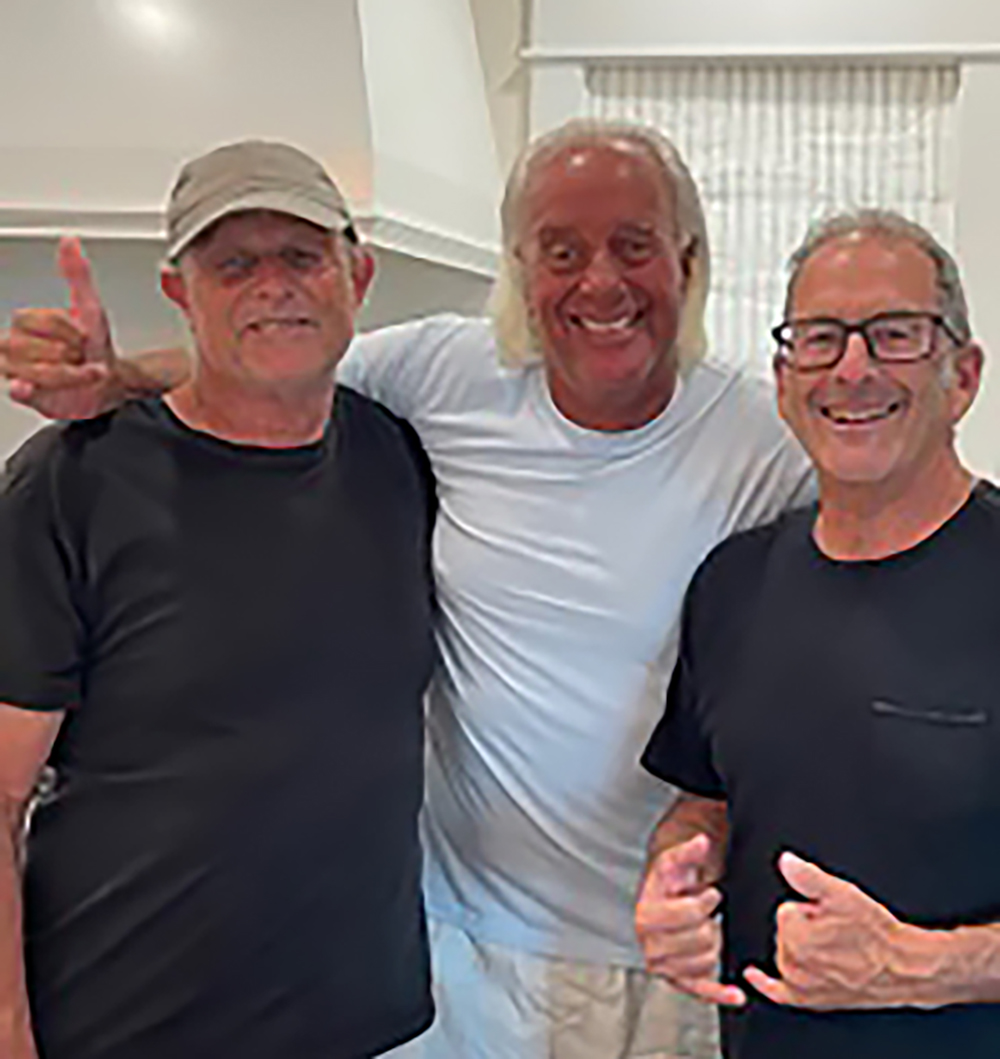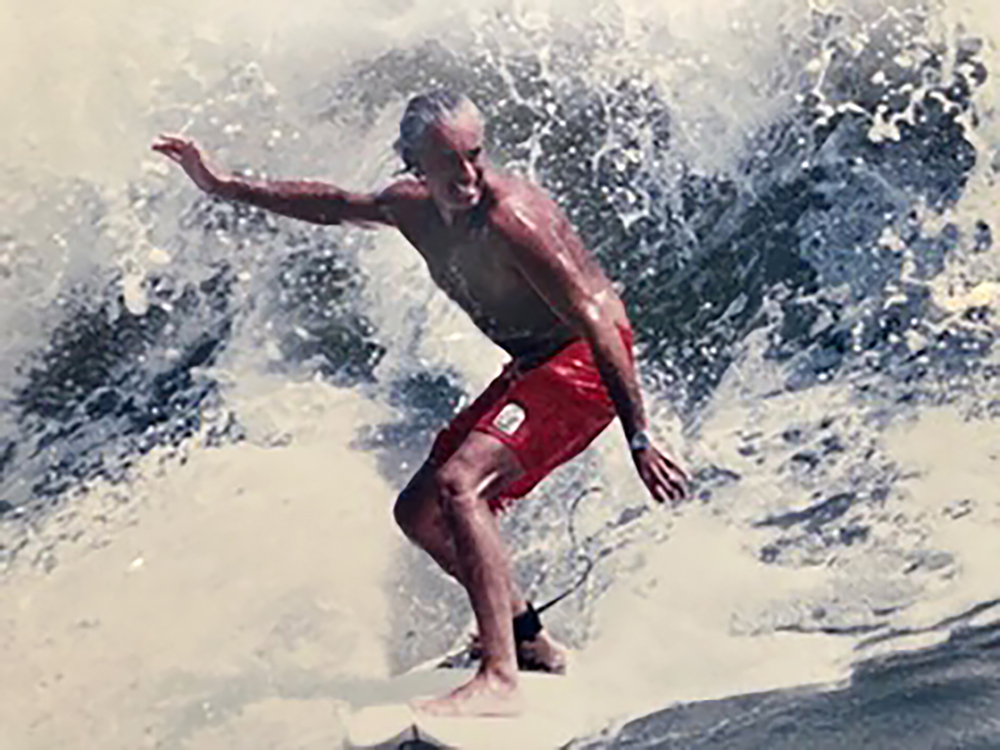Four local childhood friends catch waves in their 70s
Life is What Happens
By Lisa Zaslow Segelman
The Hawaiian Shaka hand gesture — the three middle fingers tucked into the palm while the thumb and pinky fingers are extended and waving back and forth — is understood by surfers all over the world. It means “everything’s okay”, “hang loose”, “take care” and “thank you”.
Surfers get it and apparently so does the rest of the world as it’s now an emoji, the acid test for concepts that have made it into pop culture. By choosing the “shaka emoji” you can text your pals that everything’s copacetic and tap into surfing culture at the same time.
But surfing wasn’t always so popular on Absecon Island and the rest of the East Coast and there’s people around who remember just how primitive it was.
“When I was 7-years-old in 1959 in Atlantic City, there were maybe a couple hundred dedicated riders on the East Coast,” says Lou Solomon, one of the gang of four 70+ local surfers and co-director of the Ventnor City Surf School Recreation. “I guess my friends and I were the trail blazers – or call it wave-blazers— before the sport was in full gear on the East Coast. There were no surf schools here in the 1960’s. We basically taught ourselves.”
Lou Solomon is a Margate resident whose parents built the Strand Motel in Atlantic City in 1954 and operated it successfully until selling it to developer Steve Wynn in 1978.

Lifelong friends and surfing buddies Jay Mizrahi, Mark Neustadter, and Lou Solomon
When Lou’s folks asked him in 1963 what he wanted for a bar mitzvah present, he answered “a surfboard.”
His parents’ response was, “Jewish boys don’t surf!”
Lou shot back, “but Mark Neustadter does and he’s Jewish!” Mark, now 70, along with pals Jay Mizrahi, 72, and Glenn Magill, 70, began a life-long friendship with surfing and each other.
“We all went to Atlantic City High School and graduated between 1970 and 1972” says Lou. “We listened to The Beach Boys and ‘Wipe Out’ by the Sufaris and decided that Surfin’ USA should extend beyond Hawaii and California to include Atlantic City down to Margate.”
Even though it was much easier to be a part of the surfing culture in Hawaii or the California coast, the boys hung tough while hanging ten (the practice of hanging your toes off the front of a longboard).
By 1966, the East and West Coast surfing populations were nearly equal, at approximately 200,000 each. Surfing gear wasn’t what it is today on either coast, which made the sport more challenging.
“Back then there was only one thickness of wetsuit, and the way it hit your abdomen you ended up with black and blue marks,” says Lou. “Now the suits are made of various thicknesses to accommodate different water temperatures. Surfers are a lot more comfortable these days and all of the improvements help increase skill level.”
The senior surfers for the most part learned on 10-foot fiberglass boards. “Now beginner boards are very soft,” says Lou. “You can stand up with stability. If a softer board hits you in the head when you go under, it’s a much softer blow.” Once surfers improve they’re more likely to purchase a real performance board.
“There were no paraffin wax bars to wax our boards in those days,” says Lou. “We used melted candle wax. I don’t want to make it sound like surfing 60 years ago was a hardship like Lincoln walking to school in the snow, it’s just that all of the advancements in gear has helped make the sport more accessible, easier to learn and more fun.”

Lou Solomon
Once the gang of four were up on their boards more than down, they rode the waves together for decades.
The guys still use surfing lingo, slang that contains some the most descriptive, extensive and amusing terms for a sport or profession on the planet. The jargon connects surfers with each other while creatively expressing their love of the wave.
Much of it peppers non-surfers’ everyday slang as well.
The guys still say they’re “stoked” when they’re pumped, really happy or excited about something. They talk about gremmies (beginners) and ho-dads— (people who come to the beach, board in hand, dip their heads in the water, and then tell everyone that they surf). The guys’ ultimate goal, even to this day, is to be “barreled” or in the hollow part of the wave when it’s breaking, one of the most desired occurrences in surfing.
Even though this tight-knit foursome has been together for the better part of 60 years, catching a wave is not a team sport.
“Surfing is an individual pursuit, but the code of conduct amongst surfers is to always have each other’s backs,” says Lou. “We don’t surf alone so we’re there to help get our buddy back up on his or her board or seek help.”
The camaraderie of the group is unmatched. “I love surfing with these guys,” says Mark Neustadter, the other bar mitzvah boy with the first surfboard. “We’ve surfed together for a combined 220 years, traveling the world over.”
The seniors respect nature as much as each other.
“You can ‘buy’ almost any other sport,” says Lou. “You can buy the best equipment, travel to the best locations, but all the money in the world can’t buy you good waves. Even in exotic Fiji there’s no guarantee. It’s all up to mother nature. It makes us appreciate decent surf every time it happens, so we never get spoiled.”
“After a good morning surf, it’s fairly likely no one can mess up your day,” says Mark.
These seniors love surfing with the succeeding generations as well. Lou surfs with his sons and grandson, and so does Glenn.
“Both of my sons have been surfing since a very early age. They’re very good,” says Glenn. “For me, most of the people I surf with now are much younger unless I’m with the guys.”
Glenn’s son Shaun and senior surfer Lou are directors of the Ventnor Surf School, which is currently part of the Ventnor summer recreation program, but may expand into a private entity by next year. This summer’s eight-week program accomodated 150 students. “More waves, less digital time is what I love about teaching,” says Lou.
While Absecon Island and especially Ventnor Fishing Pier will always be home base, the group does venture off the island to surf in other regions and even other countries.
“We like Rincon, Puerto Rico which is an easy trip as it’s a U.S. territory,” says Glenn. The group has also caught waves in Barbados, Nicaragua and Costa Rica.
Still, on any lovely morning, you can catch one or all of the senior surfers catching a wave on either side of the Ventnor Pier.
“Our best surfing season on Absecon island is from August 1 to November 1,” says Lou. “Perfect conditions involve a major hurricane 1,000 miles off our coast that’s moving straight up north. We benefit from the groundswell effect it creates.”
I guess there’s no place like home.
“We have to say that” says Lou with a smile and a laugh, “The last thing we want to do is make waves here in the ocean where it all started for us. Or maybe we do want to make waves.”
Lisa is an advertising copywriter (think ‘Madmen’ without the men), journalist and columnist. Claim to fame: Lou’s waitress for four teenage summers. For column comments, story ideas, or to get on her “quote” list for future columns: redshoeslzs@gmail.com










